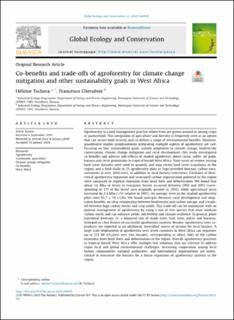| dc.description.abstract | Agroforestry is a land management practice where trees are grown around or among crops or pastureland. This integration of agriculture and forestry is frequently seen as an option that can secure food security and co-deliver a range of environmental benefits. However, quantitative studies simultaneously integrating multiple aspects of agroforestry are rare. Focusing on four sustainability goals, namely adaptation to climate change, biodiversity conservation, climate change mitigation and rural development, this study investigated co-benefits and adverse side-effects of shaded agroforests above cocoa, coffee, oil palm, banana and citrus plantations in tropical humid West Africa. Time series of remote sensing land cover datasets were used to quantify and map recent land cover transitions in the region, and a field study in 25 agroforestry plots in Togo provided biomass carbon measurements in over 3000 trees, in addition to local farmers interviews. Estimates of theoretical agroforestry expansion and associated carbon sequestration potential in the region were compared to regional emissions from fossil fuels and deforestation. We found that about 1.6 Mha of losses in evergreen forests occurred between 1992 and 2015 (corresponding to 17% of the forest area originally present in 1992), while agricultural areas increased by 2.4 Mha (+5% relative to 1992). On average, trees in the studied agroforestry plots store 83.7 ± 7.0 t C/ha. We found synergies between rural development and adaptation benefits, no clear relationship between biodiversity and carbon storage, and a trade-off between high carbon stocks and crop yields. This trade-off can be minimized with an optimal management of agroforestry by using a mix of tree species that store medium carbon stocks and can enhance yields, soil fertility and climate resilience. In general, plant functional diversity, i.e. a balanced mix of shade trees, fruit trees, palms and bananas, emerged as a key feature of successful agroforestry systems. Besides, agroforestry trees co-products are reported as an additional, diversified source of income for local farmers. A large-scale deployment of agroforestry over seven countries in West Africa can sequester up to 135 Mt CO2/year over two decades, corresponding to about 166% of the carbon emissions from fossil fuels and deforestation in the region. Overall, agroforestry practices in tropical humid West Africa offer multiple-win solutions that are relevant to address major local and global environmental challenges. Increasing cooperation among local farmer communities, national authorities, and international organizations are instrumental to overcome the barriers for a future expansion of agroforestry systems in the region. | en_US |

